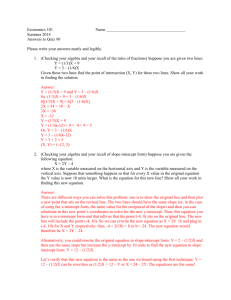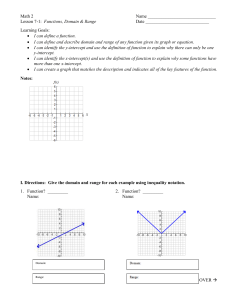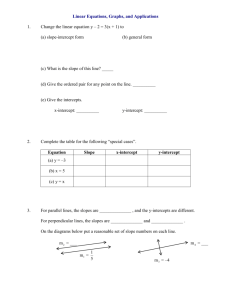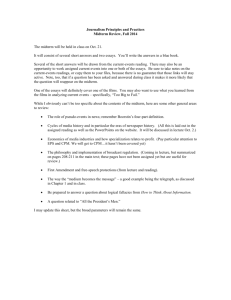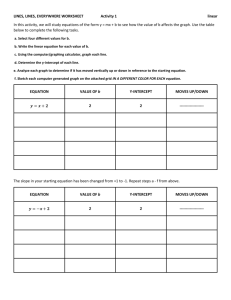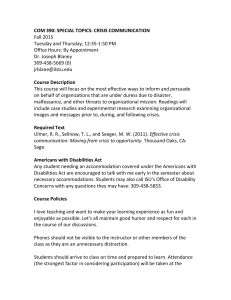Economics 101 Name Summer 2015 Answers to Quiz #0 Please
advertisement
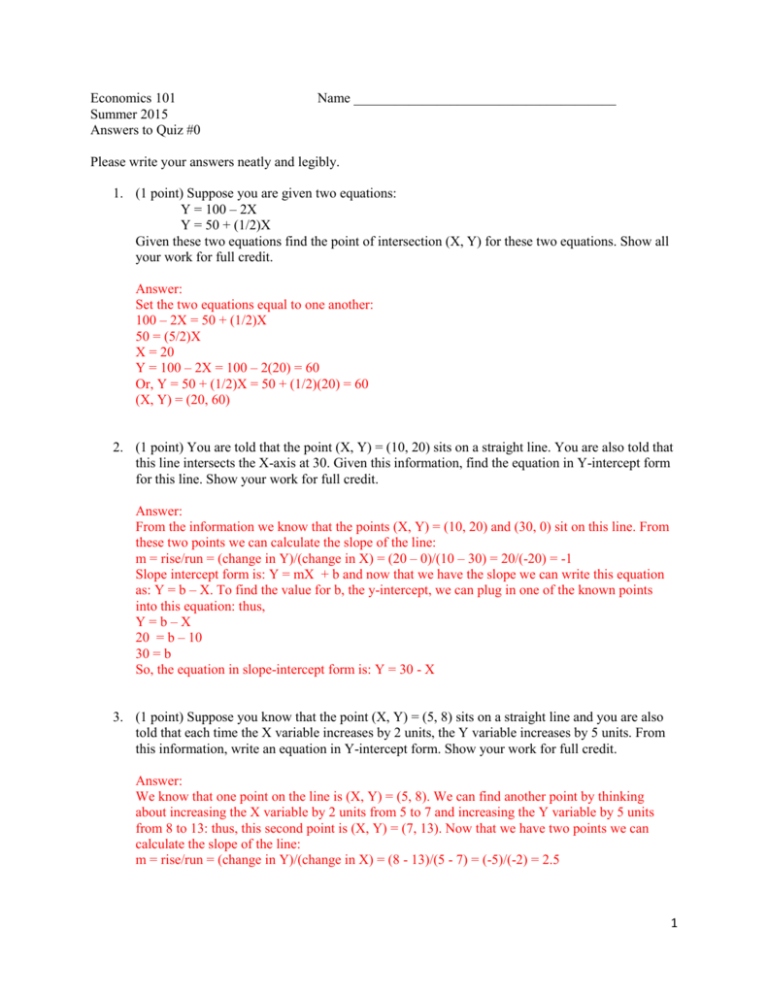
Economics 101 Summer 2015 Answers to Quiz #0 Name ______________________________________ Please write your answers neatly and legibly. 1. (1 point) Suppose you are given two equations: Y = 100 – 2X Y = 50 + (1/2)X Given these two equations find the point of intersection (X, Y) for these two equations. Show all your work for full credit. Answer: Set the two equations equal to one another: 100 – 2X = 50 + (1/2)X 50 = (5/2)X X = 20 Y = 100 – 2X = 100 – 2(20) = 60 Or, Y = 50 + (1/2)X = 50 + (1/2)(20) = 60 (X, Y) = (20, 60) 2. (1 point) You are told that the point (X, Y) = (10, 20) sits on a straight line. You are also told that this line intersects the X-axis at 30. Given this information, find the equation in Y-intercept form for this line. Show your work for full credit. Answer: From the information we know that the points (X, Y) = (10, 20) and (30, 0) sit on this line. From these two points we can calculate the slope of the line: m = rise/run = (change in Y)/(change in X) = (20 – 0)/(10 – 30) = 20/(-20) = -1 Slope intercept form is: Y = mX + b and now that we have the slope we can write this equation as: Y = b – X. To find the value for b, the y-intercept, we can plug in one of the known points into this equation: thus, Y=b–X 20 = b – 10 30 = b So, the equation in slope-intercept form is: Y = 30 - X 3. (1 point) Suppose you know that the point (X, Y) = (5, 8) sits on a straight line and you are also told that each time the X variable increases by 2 units, the Y variable increases by 5 units. From this information, write an equation in Y-intercept form. Show your work for full credit. Answer: We know that one point on the line is (X, Y) = (5, 8). We can find another point by thinking about increasing the X variable by 2 units from 5 to 7 and increasing the Y variable by 5 units from 8 to 13: thus, this second point is (X, Y) = (7, 13). Now that we have two points we can calculate the slope of the line: m = rise/run = (change in Y)/(change in X) = (8 - 13)/(5 - 7) = (-5)/(-2) = 2.5 1 Slope intercept form is: Y = mX + b and now that we have the slope we can write this equation as: Y = b + 2.5X. To find the value for b, the y-intercept, we can plug in one of the known points into this equation: thus, Y = b + 2.5X 8 = b + 2.5(5) (-4.5) = b So, the equation in slope-intercept form is: Y = 2.5X – 4.5 4. (2 points) Suppose that you know the points (X, Y) = (10, 10) and (20, 5) sit on a straight line. For each of the following coordinate points determine whether the point sits on this straight line, sits below the straight line, or sits above the straight line. a. (X, Y) = (4, 13) _____________________________________ b. (X, Y) = (22, 5) _____________________________________ c. (X, Y) = (8, 9) ______________________________________ d. (X, Y) = (25, 2.25) __________________________________ Workspace: Answer: The equation for the line is Y = 15 – (1/2)X. To get this equation you needed to find the slope of the line: m = rise/run = (10 – 5)/(10 – 20) = (-1/2). And, then use one of the given points to find the y-intercept value. For point (a): If X = 4, you can use the equation you found to figure out if the Y value is equal to 13, greater than 13, or less than 13. So, when X = 4, the equation tells us that Y should equal 13. Thus, the point (X, Y) = (4, 13) sits on the line. For point (b): If X = 22, you can use the equation you found to figure out what the Y value is. Thus, Y = 15 – (1/2)(22) or Y = 4. The point (22, 5) sits above the line. For point (c): If X = 8, you can use the equation you found to figure out what the Y value is. Thus, Y = 15 – (1/2)(8) or Y = 11. The point (8, 9) sits below the line. For point (d): If X = 25, you can use the equation you found to figure out what the Y value is. Thus, Y = 15 – (1/2)(25) or Y = 2.5. The point (25, 2.25) sits below the line. To summarize: a. (X, Y) = (4, 13) _______Sits on the line______________________________ 2 b. (X, Y) = (22, 5) _______Sits above the line______________________________ c. (X, Y) = (8, 9) _________Sits below the line_____________________________ d. (X, Y) = (25, 2.25) _______Sits below the line___________________________ 5. (1 point) Suppose you are given the following equation: X = 100 – 2Y You are told that something happens so that at every Y value the X variable has now decreased by 25 units. Given this change, write an equation in Y-intercept form for this new line. Show your work for full credit. Answer: First, let’s write the initial equation in Y-intercept form: X = 100 – 2Y 2Y = 100 – X Y = 50 – (1/2)X The new line is parallel to the initial line, but has shifted horizontally to the left by 25 units. Thus, if the Y-intercept of the initial line is (0, 50) we now know that the point (-25, 50) sits on this new line. We can use this point and our slope value to compute the new equation: Y = mX + b Y = (-1/2)X + b Plug in (X, Y) = (-25, 50) into this equation. Thus, 50 = (-1/2)(-25) + b 37.5 = b The equation for the new line is Y = 37.5 – (1/2)X Alternatively, you could start with the X-intercept form of the equation you were given and recognize that if the X-intercept is initially 100, the new line will have an X-intercept of 75 (the new X-intercept will be 25 units smaller than the initial X-intercept). Thus, the new line in Xintercept form can be written as X = 75 – 2Y. Rearrange this equation into Y-intercept form and you have: X = 75 – 2Y 2Y = 75 – X Y = 37.5 – (1/2)X 6. (2 points) Susie is currently taking Math 112 and her grade is based upon three midterms and a final. Each of the midterms contributes 20% of her final grade based upon each midterm being graded on a 100 point scale. Her final exam contributes the remaining 40% of her grade based upon the final being graded on a 100 point scale. Her professor though enjoys giving exams that are not based on 100 point scales. So Susie would like your help in figuring out what score she needs on the final to get an AB in the class. She knows that she needs to have a total score of 80 based on the above weights in order to get an AB and she also knows her midterm scores and how many points were available on each exam. Here are the data she has: Assignment First Midterm Susie's Score 35 Total Number of Points on Exam 50 points 3 Second Midterm Third Midterm Final 120 30 not yet taken 150 points 40 points 80 points First, convert these scores to a 100 point scale and fill in your answers in the table below: Assignment First Midterm Second Midterm Third Midterm Final Answer: Assignment First Midterm Second Midterm Third Midterm Final Susie's Score on a 100 point scale --- Susie's Score on a 100 point scale (35/50)*100 = 70 points (120/150)*100 = 80 points (30/40)*100 = 75 points --- Now, compute the score Susie needs to make on her final exam on a 100 point scale in order to earn an AB. Then, convert this score to what she needs to make on this final exam given that it is an 80 point exam. Show all your work to get full credit here! Answer: Let x be the score on the final measured on a 100 point scale. Then, .2(Score on First Midterm on 100 point scale) + .2(Score on Second Midterm on 100 point scale) + .2(Score on Third Midterm on 100 point scale) + .4(Score on Final on 100 point scale) = 80 So, .2(70) + .2(80) + .2(75) + .4(x) = 80 14 + 16 + 15 + .4x = 80 .4x = 35 x = 87.5 as measured on a 100 point scale But, the final is on an 80 point scale so we need to convert this score. y/80 = 87.5/100 where y is the final exam score on an 80 point scale. Or, y = (87.5/100)*80 = 70 Susie needs to make a 70 out of 80 points on the final to earn a B in the class. 7. (2 points) Maria deposits $5,000 in a savings account at her local credit union on the first day of the year. Monies deposited in this account earn 3% a year and this interest is put into the account on the final day of the year. Maria plans to keep this amount in her savings account for a full two years so this means that she will earn interest after the first year and this interest will simply be added to her account so that she will earn interest during the second year on her initial deposit plus the interest she earned the first year (this is known as “compounding”). Given this information, show how you would calculate the value of Maria’s deposit at the end of the first year once she has earned the first year interest payment. Answer: 4 At the end of the first year Maria will have $5000(1 + .03) in her account after she receives the interest payment. She will have $5150. Given this information, show how you would calculate the value of Maria’s deposit at the end of the second year once she has earned the second year interest payment. Answer: At the end of the second year Maria will have ($5000)(1 + .03)(1 + .03) in her account after she receives the interest payment for the second year. She will have $5304.50 5
